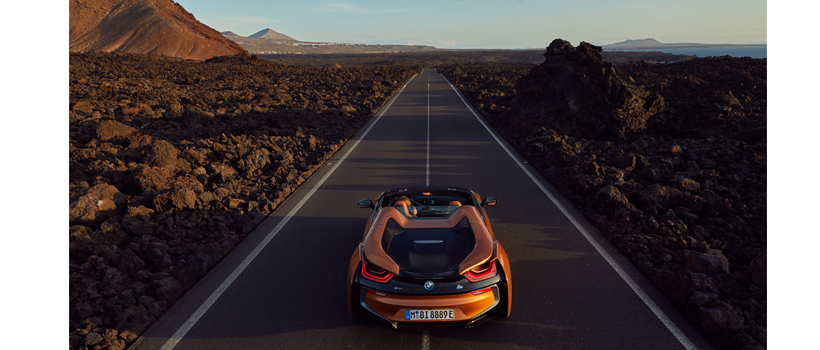*See images in the photo gallery above
BMW introduced the new BMW i8 Roadster with BMW eDrive technology at the LA Auto Show.
The Roadster features a total output of 369 horsepower and an electric charge that can cover up to 18 miles in purely electric driving, according to the company. With hybrid-specific all-wheel drive, combustion engine driving the rear wheels and the electric motor driving the front wheels, acceleration zero to 60 mph takes just 4.2/4.4 seconds. The company also will return with a coupe hypbrid. The coupe and roadster both reach an electronically limited top speed of 155 mph.
Sales of both new vehicles will commence in spring 2018.
The first-ever BMW i8 Roadster benefits from a lightweight construction, complete with low center of gravity and even weight distribution. The aerodynamically optimized exterior features model-specific gullwing doors and a soft-top roof.
Powertrain
The new BMW i8 Coupe and BMW i8 Roadster are powered by a drive duo in the form of a hybrid synchronous electric motor and BMW TwinPower Turbo technology 1,499 cc three-cylinder gasoline engine. The engine’s power is channeled to the rear wheels through a six-speed Steptronic automatic transmission, while the electric motor propels the front wheels via a two-speed automatic gearbox. The end result is a hybrid-specific all-wheel-drive system that glues the car to the road.
The i8’s combustion engine has also undergone further optimization to ready it for the new Coupe and Roadster. The turbocharged three-cylinder unit featuring direct injection and VALVETRONIC variable valve timing extracts a maximum output of 228 horsepower from its displacement of just 1.5 liters, plus peak torque of 236 lb-ft.
Combined fuel economy in everyday driving, both models return fuel economy and emissions figures that undercut those for conventionally powered sports cars with similar outputs by around 50 percent, yielding approximately 70 MPG, according to BMW.
In hybrid mode, the electric motor provides a power boost to assist the engine when vigorous acceleration is required. The electric motor is also able to recuperate energy and feed it to the high-voltage battery on the overrun and under braking. The gasoline engine’s high-voltage starter-generator can similarly generate additional reserves of electricity, thereby ensuring that sufficient energy is on tap at all times for the electric drive system in the new BMW i8 Coupe and first-ever BMW i8 Roadster.
Engine Balance
The number of driving situations where the electric motor is solely responsible for powering the car has been significantly increased. By contrast, the combustion engine is only brought into play when accelerating hard, and is switched off again far more frequently with a measured driving style, according to BMW.
Underpinning this new level of locally emission-free electric mobility is the updated version of the lithium-ion battery developed for the BMW i8. The high-voltage unit is located centrally in the car’s underbody and its cell capacity is up from 20 to 34 Ah and gross energy capacity from 7.1 to 11.6 kilowatt hours. Plus, the cell configuration allows a 12 hp increase in peak output to 141 hp and 184 lb-ft of torque, lacing quick sprints on pure-electric power with an even sharper streak of dynamism, according to the company.
Raise the Roof
Passengers inside the first-ever BMW i8 Roadster can either enjoy the open sky or the all-season fabric soft-top with additional soundproofing. The electrically operated convertible top opens and closes in less than 16 seconds and while the vehicle is in motion at up to 31 mph.
Opening the roof raises the rear window automatically by around 1.9 inches into a comfort position. By raising the rear window, the air flow is guided towards the rear, reducing wind turbulence optimizing the passenger’s experience, according to the company. The driver can adjust the height of the rear window at the touch of a button to control the impact of the inflowing air as desired.
3D Printed Components
Aluminum elements connecting the roof mechanism with the body of the new BMW i8 Roadster are produced in a new 3D printing process. This manufacturing method for aluminum components breaks new ground in the automotive industry and allows the topologically optimized bracings to be produced in a geometric form, which would not be possible using conventional casting techniques and ensures an optimal balance between component rigidity and weight, according to BMW.
